|
|
|
Sort Order |
|
|
|
Items / Page
|
|
|
|
|
|
|
| Srl | Item |
| 1 |
ID:
127872
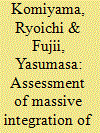

|
|
|
|
|
| Publication |
2014.
|
| Summary/Abstract |
Maximizing renewables in the country's power system has been a key political agenda in Japan after the Fukushima nuclear disaster. This paper investigates the potential of PV resource, which could be systematically integrated into the Japanese power system, using a high time-resolution optimal power generation mix model. The model allows us to explicitly consider actual PV and wind output variability in 10-min time resolution for 365 days. Simulation results show that, as PV expands, the growth of PV integration into the grid slows down when the installed PV capacity is more than the scale of the peak demand, although Japan has immense potential of installable PV capacity - equivalent to 40 times of the peak. Secondly, the results imply that a large-scale PV integration potentially decreases the usage ratio of LNG combined cycle (LNGCC) in specific seasons, which is a challenge for utility companies to ensure that LNGCC is used as a profitable compensating generator for PV variability. Finally, a sensitivity analysis on rechargeable battery cost suggests that the reason for suppressing the PV output instead of storing its surplus output by the battery can be attributed to the high battery cost; hence, the improvement of its economic performance is significant to integrate the massive PV energy.
|
|
|
|
|
|
|
|
|
|
|
|
|
|
|
|
| 2 |
ID:
114852
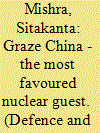

|
|
|
| 3 |
ID:
134084
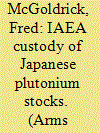

|
|
|
|
|
| Publication |
2014.
|
| Summary/Abstract |
Even before the 2011 Fukushima nuclear disaster shut down all 48 Japanese nuclear reactors, Japan's plan to reprocess its spent nuclear fuel and use the recovered plutonium and uranium as mixed-oxide (MOX) fuel in its nuclear power plants suffered from significant delays.
|
|
|
|
|
|
|
|
|
|
|
|
|
|
|
|
| 4 |
ID:
124594
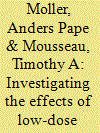

|
|
|
|
|
| Publication |
2013.
|
| Summary/Abstract |
The disasters at Chernobyl and Fukushima released large amounts of radioactive material, equivalent to many hundreds of nuclear bombs the size of those at Hiroshima and Nagasaki. Currently, there is worldwide interest in the effects of so-called low-dose radiation on public health and on biological systems from molecules to ecosystems. Research efforts to quantify these effects constitute a curious mixture of Soviet science, research by independent scientists, and research supported by the nuclear industry. The article explains how navigating between these diverse efforts can be reconciled to synthesize available information to the benefit of the general public and the policymaking community.
|
|
|
|
|
|
|
|
|
|
|
|
|
|
|
|
| 5 |
ID:
128323
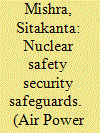

|
|
|
|
|
| Publication |
2013.
|
| Summary/Abstract |
Since its inception, nuclear technology has evoked a sense of zeal as well as awe because of its immense constructive and destructive potential. By now, the world has come a long way, experiencing both: around 540 nuclear reactors operating in countries producing 372,000 MWe (13.5 percent of the world`s electricity), radioactive materials used in many sectors enriching human life; on the other hand, two nuclear bomb have been used in war and around 19,000 more are stockpiled; during the same time, three major nuclear accidents occurred, resulting in some human suffering, and misuse of nuclear material by non-states actors is widely apprehended. Therefore, the balance sheet may be argued to be mixed, implying that we succeeded as much we failed with nuclear technology. After the Fukushima nuclear disaster, what would be the fate of nuclear technology or which direction the nuclear energy discourse will move in has been a matter of speculation. This study, premised on the assumption that nuclear technology or nuclear energy cannot be ignored as it has an edge over other for a better management paradigm by looking beyond the design basis threats to address inherent loopholes. Deconstructing the real and assumed threats (accident, misuse, and terror), this study prescribes a coherent and integrated strategy devoid of political and social panic.
|
|
|
|
|
|
|
|
|
|
|
|
|
|
|
|
| 6 |
ID:
124593
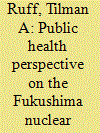

|
|
|
|
|
| Publication |
2013.
|
| Summary/Abstract |
The Fukushima nuclear disaster is far from over and remains a global health concern. While evacuations, sheltering, reducing intake of contaminated food, and other measures reduced radiation exposures, both the immediate and longer-term public health responses to the disaster leave major room for improvement. Commercially and institutionally, vested interests have undermined public health and safety.
|
|
|
|
|
|
|
|
|
|
|
|
|
|
|
|
| 7 |
ID:
118943


|
|
|
|
|
| Publication |
2013.
|
| Summary/Abstract |
The Fukushima nuclear disaster highlighted the relevance of effective risk communication strategies for nuclear accidents. Poor risk communication was evidenced during the crisis and its aftermath. The government's mishandling of radiation issues generated concern in international nuclear agencies as well as widespread anxiety among Japanese citizens. Based on anthropological research, I will argue that among the negative consequences of the government's inability to deal with public fears are the citizens' uncertainty and ongoing distrust toward the government, the safety regulators, and the nuclear industry. I will also suggest that such harmful effects can be mitigated by enhancing transparency of the decision-making process and by implementing participative programs where policy makers, stakeholders, and representatives of the local communities can jointly discuss energy production schemes.
|
|
|
|
|
|
|
|
|
|
|
|
|
|
|
|
| 8 |
ID:
132904


|
|
|
|
|
| Publication |
2014.
|
| Summary/Abstract |
The trifecta of disasters in japan that unfolded on 1 1 March 201 1 strains credibility: a 9.0-level earthquake (the largest ever recorded in Japan), a thousand- year tsunami that devastated a 300-kilometer stretch of coastline in northeastern Japan, and three nuclear reactors in meltdown, exposing signi?cant portions of japan to potentially dangerous levels of radiation. In the aftermath of these unprecedented disasters, the meaning and signi?cance of this disaster have evolved. As Japanese government authorities and the general public alike have come to un(ierstand the nuclear disaster in more nuanced terms, retrospective evaluations now cast this crisis in its historical context and are coming to calibrate the level of significance in more consistent terms than was the case in the immediate aftermath of the disaster. This article analyzes how media and government authorities assessed the Liu Kushima nuclear disaster from its onset and considers how cultural frames of reference came into play, leading to selective perceptions about the nature of the accident and its presumed effects. The author discusses the nuclear disaster as a "moral panic," as the media constructed a narrative arch that ampli?ed perceptions of risk in often melodramatic terms, filtering information that shaped public perception and influenced the action of decision-making elites. In addition to discussing how the nuclear disaster affected Japanese domestic politics, the article addresses the impact of the nuclear disaster on international alliances and its implications for the nuclear industry.
|
|
|
|
|
|
|
|
|
|
|
|
|
|
|
|
| 9 |
ID:
118120
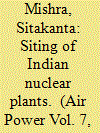

|
|
|
|
|
|
|
|